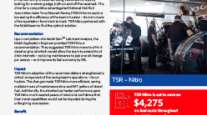Rising Crude Price Pushes Diesel, Gas to Highest Levels in 2 Years
This story appears in the Dec. 20 & 27 print edition of Transport Topics.
U.S. retail motor fuel prices continued to climb last week as both diesel and gasoline reached two-year highs, the Department of Energy said.
The average price of a gallon of diesel rose 3.4 cents last week to $3.231 a gallon, and the gasoline average gained 2.2 cents to $2.98, DOE said Dec. 13 after its weekly survey of filling stations.
Trucking’s main fuel is now 48.3 cents higher than the corresponding week a year ago, while gasoline is 38.1 cents more expensive than last year, according to the review of prices at some 350 filling stations.
“The main reason behind the climb in retail fuel prices is crude oil, crude oil, crude oil,” Neil Gamson, economist at DOE’s Energy Information Administration, told Transport Topics. “It’s been trading in the $90-a-barrel range, its highest price in two years, and that’s been the main force behind the rise of fuel prices.”
Crude oil closed at $88.62 a barrel Dec. 15 at the New York Mercantile Exchange, Bloomberg News reported. Crude has risen as high as $89.38 a barrel in its current run-up.
Diesel is at its highest since the $3.288 average of Oct. 27, 2008, when it was coming off the historic highs of that summer. Gas is at its highest since Oct. 13, 2008.
“This large increase in diesel prices is obviously affecting our cash flow somewhat, because though we have a fuel surcharge and we’re successful at receiving it, we don’t get paid for 30 days, so we’re forking out that money upfront,” Joe Herman, president and owner of Danny Herman Trucking Co., Mountain City, Tenn., told TT.
Herman added that the company has recently begun two equipment changes to try to increase fuel economy. He said the company has 250 tractors and 700 trailers.
“We’ve begun putting trailer skirts on, mainly to meet California requirements,” Herman said. “We’ve got them on about 14% of our trailers so far, and our tests show an increase of 0.3% in fuel economy.”
The company is also installing auxiliary power units on its trailers.
“Each of them also improves fuel economy about 0.3%,” Herman said.
Patrick Cozzens, president of Modern Transportation Services Inc., Pittsburgh, said that fuel saving programs the company implemented has allowed it to weather the current price surge.
“We have a very stringent program on tracking fuel, using on-board computer programs to track miles per gallon, both by individual drivers and by managers, and that has been highly, highly successful,” Cozzens told TT.
“Our top 10% of drivers get seven miles per gallon,” Cozzens said. He said the bottom 10% of drivers get 5.5 mpg or worse and are urged to improve or seek employment elsewhere.
Modern Transportation, which runs 200 tractors, also has a “closed network” of fueling stations that drivers must use to refill, all of which give the company discounts.
Phil Flynn, senior energy analyst at futures brokerage firm PFGBest, Chicago, said that besides crude oil, there were a few other factors affecting U.S. pump prices.
“Gasoline really has been leading the charge in retail price increases, and it goes back to the French refinery strike that disrupted prices in Europe and impacted prices here,” Flynn told TT. “That produced a scramble for supplies in other European nations, and impacted imports to our East Coast.”
Flynn said that a later “rash of refinery problems and pipeline line problems in the U.S. tightened supplies up even more.”
A colder start to winter than usual in both Europe and the U.S. East Coast pushed up demand for heating oil higher than expected, and put more upward pressure on diesel prices.
Flynn also cited the weakening dollar as another factor, as traders bought crude and other commodities as protection.




